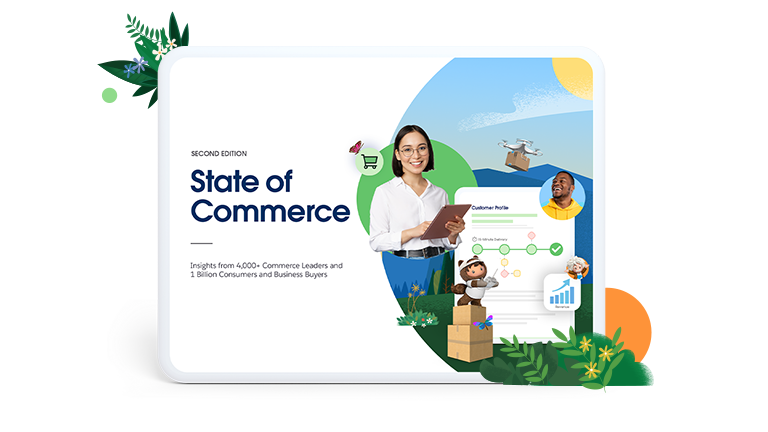Pre-pandemic, e-commerce in South Africa lagged behind, however, its growth since then has been staggering. The number of online shoppers jumped 66% in the last three years and is projected to grow another 35% in the next three.
A Visa survey found that 64% of consumers in South Africa bought groceries online for the first time because of the pandemic – and companies were not prepared for this shift. Grocery delivery Zulzi, limited shopping to two hours a day after its app was overwhelmed, and is now processing five times as many orders as in 2019.
And it’s not just consumer brands, 83% of B2B e-commerce organisations are now selling online, investing in customer self-service online and are expecting digital share to hit 49%.
This growth is as exciting as it is challenging. The question for South African brands is how to seize the potential in front of them – to reach the 335 million buyers shopping online in the region and the billions beyond its borders.
We polled over 4,000 commerce professionals around the world (including your peers in South Africa) about buying trends and how companies are navigating them.
State of Commerce Report
Get a pulse on what over one billion customers think, and how 4,000+ commerce professionals are meeting new expectations, market conditions, and revenue opportunities.

The results speak to a behavioural shift in how buyers shop online – moving fluidly between channels and devices. Buying journeys are becoming hybrid and fragmented, split between digital and physical experiences, like buying online to pick up in-store later. Likewise, B2B buyers often purchase through third-party sites.
Many technologies and disciplines have to line up to synthesise these cross-channel experiences into one smooth experience – across your website, advertising, marketing touchpoints, in-store experiences and beyond.
In this blog, we’re going to explore three primary factors that help drive e-commerce success in South Africa, whether you’re in B2C or B2B:
- Connected systems
- Customer-centricity
- Personalised experiences
Ready? Let’s get started.
1. Connected systems
Engagement is now omni-channel: customers move between an average of nine different channels to communicate with companies, and over three-quarters have used multiple channels to start and complete a transaction.
Buyers in South Africa want speed, convenience, and consistency in every interaction – and most companies in the region are struggling to catch up.
A vast majority (92%) of consumers in South Africa expect consistency across departments and have low tolerance for clunky experiences. When they call customer service about a product they bought, they expect the agent to have all their information available immediately.
Consistency across departments is challenging to deliver, especially when e-commerce, marketing, sales and customer service departments use different systems. Many don’t integrate, and it takes a lot of engineering to connect them. (Not to mention all the additional work required when any individual element releases a significant update.)
So, how do you overcome technology constraints?
Focus on connecting systems across your company’s tech stacks. When choosing an e-commerce platform in South Africa, don’t just evaluate its features, look at how easy it is to connect it with other systems across your business — off-the-shelf integrations being the gold standard.
Headless commerce is also gaining momentum as organisations want the flexibility to build new digital initiatives. It breaks down many siloes while letting teams adjust storefronts and other digital experiences – without putting extra strain on developers (or causing more bottlenecks).
2. Customer-centricity
E-commerce success favours brands that put the customer at the centre of every decision. But customer preferences are a moving target. Whether it’s B2B buyers shifting to virtual meetings or consumers wanting to use new payment methods, their needs change fast.
But not every company is set up to react quickly. Globally, 27% of digital leaders can change an online storefront in a few hours, while only 16% of laggards can. And even then, some digital leaders report it takes weeks – or even months – to make changes.
Difficulty keeping up with changes has led many companies to embrace headless architecture: a decoupling of the back and front end of commerce. Headless architecture makes it easy for commerce companies to pivot with change, rapidly change their storefronts, and add new channels.
Brands use this flexibility to offer new payment and pickup options that customers love. And business sellers are adopting flexible fulfilment as well, globally, 51% of B2B buyers report using curbside pickup more than they did a year ago, and 55% expect to be using these options more within the next three years.
Headless architecture makes it possible to build customer experiences while ensuring cross-channel coordination via APIs. Since changing front-end experiences doesn’t require much engineering, businesses can react to new trends and launch front-end experiences quickly and cheaply.
The top benefits of headless architecture, according to e-commerce pros in South Africa:
- Increased agility (making changes faster): 73%
- Improved integration between systems: 73%
- More flexibility (able to customise digital experiences): 72%
Headless architecture also provides a less obvious benefit: employees tend to be more comfortable using it. There’s a lower learning curve when there’s a consistent menu of options on the front end. This means employees without specialised skills can still access and update their storefronts.
3. Personalised experiences
Personalisation makes purchasing easier for customers and creates loyalty-building experiences. And, in South Africa, the verdict is that 90% of organisations in South Africa say personalising e-commerce experiences is important for them.
Customers have learned from giants like Amazon to look for the signals of personalisation right from your storefront – with tailored recommendations based on their preferences that anticipate needs they didn’t know they had. The trouble is, while it’s table stakes for customers, it’s quite hard to deliver in practice.
It requires:
- Synthesising signals about customer preferences across many channels and devices.
- Creating useful insight from that data.
- Packaging data so your various automation systems can use it.
Only 36% of South African B2C brands strongly believe they’re effective in using data to connect commerce with other areas of the business. The solution? A Customer Data Platform (CDP) does exactly that. It creates a single source of truth about each customer and links that with every platform or technology aiding customer interaction.
It also helps companies find value in their own first-party data across channels. Bringing together proprietary data from a variety of channels can deliver new customer insights and even feed growth.
In fact, businesses in South Africa expect channels like point-of-sale and customer service to start contributing more to revenue. Over half of businesses in South Africa are investing in their websites, social media, third-party marketplaces, and point-of-sale channels in the next two years.
Upholding a unified, positive customer experience across these channels is tricky but critical. Buyers – perhaps in B2B even more than in B2C – value convenience, so their post-purchase experiences drive loyalty and satisfaction. And you can only deliver that when you build technology around the customer – not data silos.
E-commerce leads the way to growth
Connecting systems, putting the customer at the heart of every decision, and leaning into personalisation will help businesses sell more and build valuable brand loyalty.
State of Commerce Report
Get a pulse on what over one billion customers think, and how 4,000+ commerce professionals are meeting new expectations, market conditions, and revenue opportunities.
























